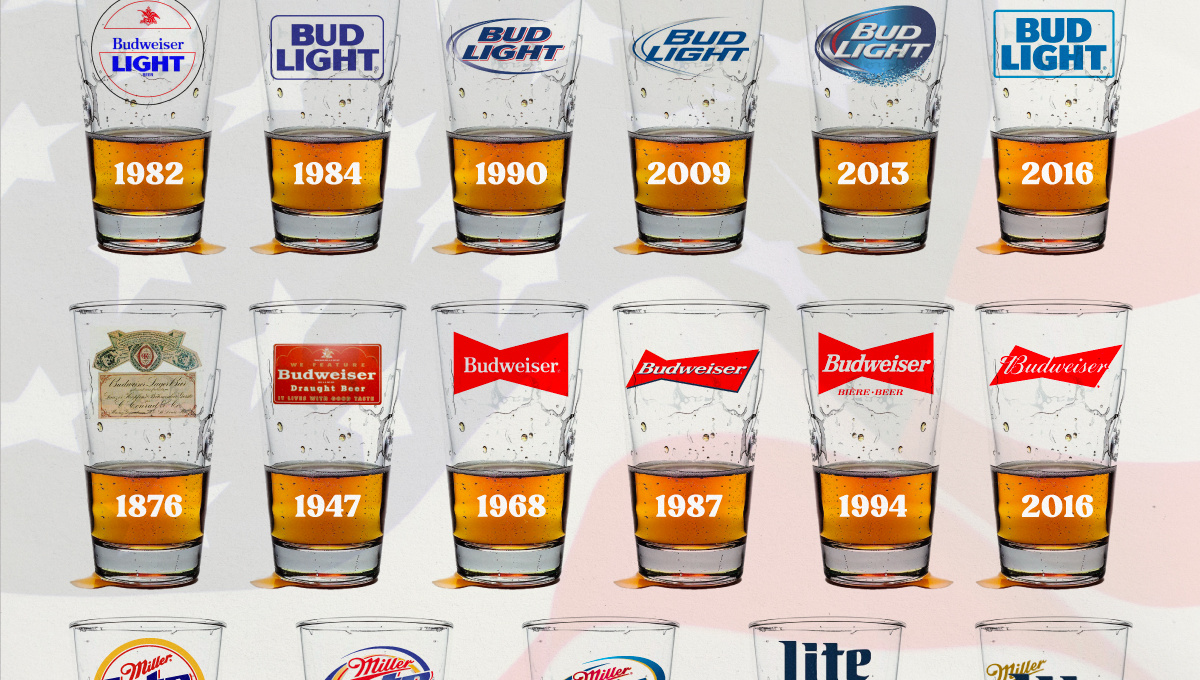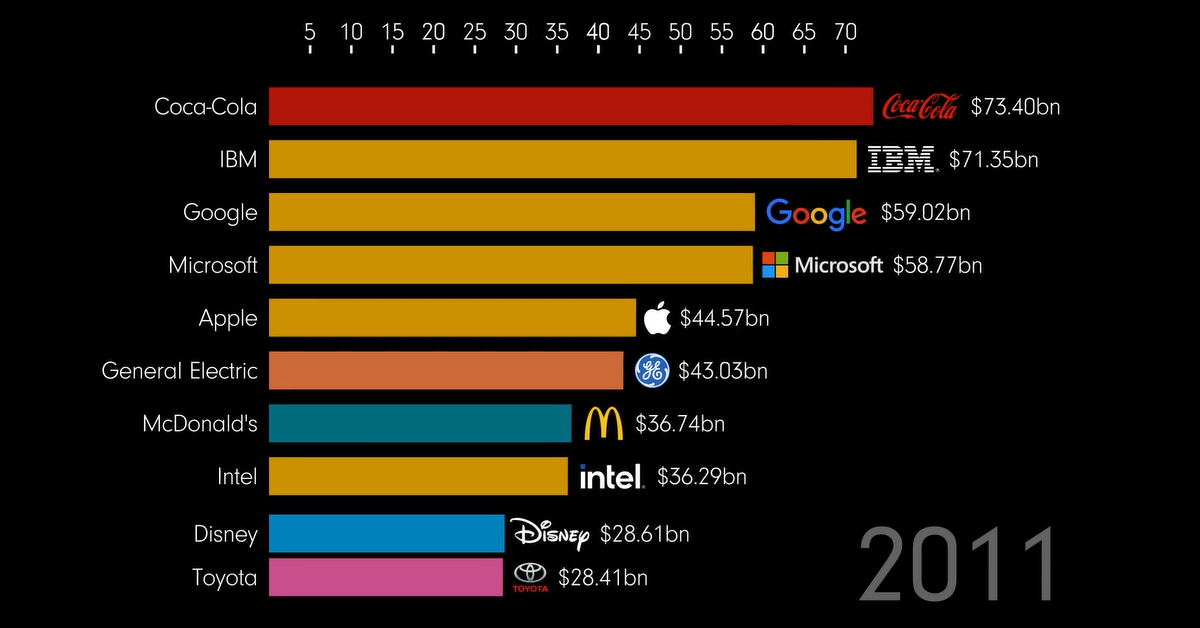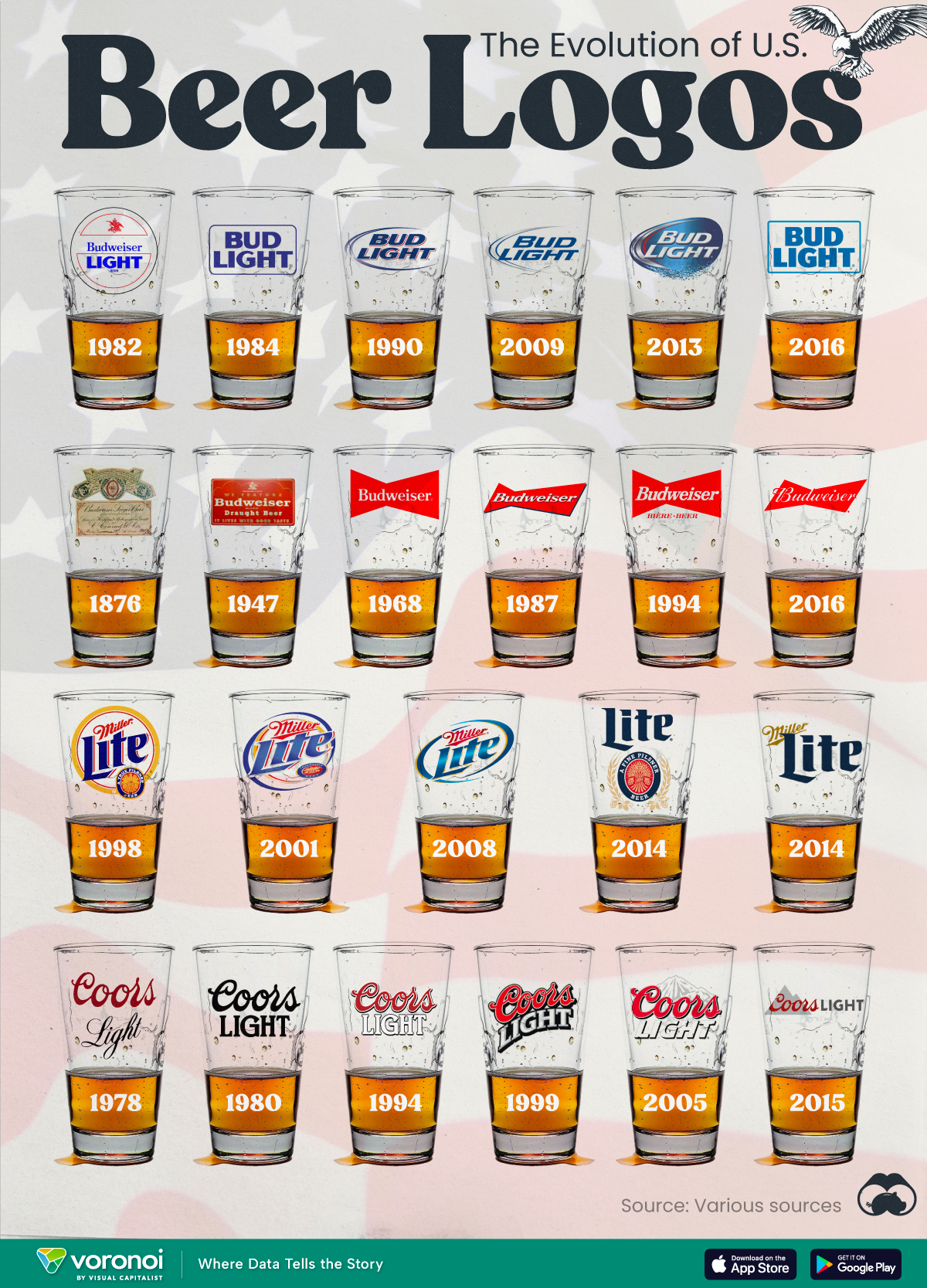Brands
Animated: The Most Valuable Brands From 2000–2022
The Most Valuable Brands From 2000–2022
How much money is a brand truly worth?
For some companies, a brand is something that helps slightly boost customer engagement and sales. But for others, including some of the largest companies in the world, a strong brand is one of their most valuable assets.
This animated graphic by James Eagle uses the annual brand rankings from Interbrand to track the world’s most valuable brands from 2000 to 2022.
Measuring Brand Value
One of the difficulties of brand valuation is its subjectivity.
In accounting, the value of a brand is sometimes represented as an intangible asset called goodwill on the balance sheet. That’s because the brand power associated with a company (i.e. brand recognition, brand loyalty, customer base, reputation, etc.) often makes a company more valuable than just the sum of its tangible assets like land, buildings, or product inventory.
This works for accounting purposes but is still a rough estimation, and doesn’t precisely quantify a brand’s true value.
For Interbrand’s studies, a consistent formula for brand strength was utilized which is based on a company’s financial forecast, brand role, and brand strength. It uses estimates of the present value of earnings a brand is forecasted to generate in the future.
The Top 10 Most Valuable Brands Since 2000
When the 2000s started, the internet was top-of-mind in terms of both markets and customer perception. The Dotcom bubble was driving the world’s largest companies, and brand value at the time reflected tech’s popularity:
| Rank | Brand | Value (2000) | Industry |
|---|---|---|---|
| 1 | Coca-Cola | $72.5B | Beverages |
| 2 | Microsoft | $70.2B | Tech |
| 3 | IBM | $53.2B | Tech |
| 4 | Intel | $39.1B | Tech |
| 5 | Nokia | $38.5B | Tech |
| 6 | General Electric | $38.1B | Energy |
| 7 | Ford | $36.4B | Automotive |
| 8 | Disney | $33.6B | Media |
| 9 | McDonald's | $27.9B | Restaurants |
| 10 | AT&T | $25.6B | Telecom |
Half of the top 10 most valuable brands at the time were in tech or telecom, including Microsoft, IBM, and Nokia.
Others were classic American brands and companies at the top of their fields, including Coca-Cola, General Electric, Ford, and McDonald’s.
But over the next 20 years, much of the old guard was replaced by new and rising brands. By 2022, only three of the top 10 most valuable brands from 2000 remained at the top:
| Rank | Brand | Value (2022) | Industry |
|---|---|---|---|
| 1 | Apple | $482.2B | Tech |
| 2 | Microsoft | $278.3B | Tech |
| 3 | Amazon | $274.8B | Consumer |
| 4 | $251.8B | Tech | |
| 5 | Samsung | $87.7B | Tech |
| 6 | Toyota | $59.8B | Automotive |
| 7 | Coca-Cola | $57.5B | Beverages |
| 8 | Mercedes-Benz | $56.1B | Automotive |
| 9 | Disney | $50.3B | Media |
| 10 | Nike | $50.3B | Consumer |
Apple’s brand is now worth an estimated $482 billion, even though the company didn’t even crack the top 10 list back in the year 2000.
In fact, four of the top five brands on the 2022 list are directly in tech, and even Amazon (#3) is often considered a tech giant. Not surprisingly, brand value in the top 10 has grown almost across the board, though Coca-Cola is a notable exception, dropping $15 billion in estimated brand value over 22 years.
How will the most valuable brands continue to evolve over the coming decades?

This article was published as a part of Visual Capitalist's Creator Program, which features data-driven visuals from some of our favorite Creators around the world.
Misc
The Evolution of U.S. Beer Logos
In this graphic, we analyze the evolution of popular U.S. beer logos like Budweiser, Coors Light, Bud Light, and more.

The Evolution of U.S. Beer Logos
This was originally posted on our Voronoi app. Download the app for free on iOS or Android and discover incredible data-driven charts from a variety of trusted sources.
Despite selling a popular product, beer companies have to be creative to stand out in a competitive market.
In this graphic, we analyze the evolution of some U.S. beer logos based on various sources. We chose brands based on a mixture of criteria, including popularity (based on YouGov surveys), availability of logo assets, and those with interesting developments.
Bud Light Back to the ’80s
Despite recent backlash and calls for a boycott after sending a commemorative can to transgender influencer Dylan Mulvaney, Bud Light remains one of America’s best-selling beers.
The brand of light beer, owned by the Anheuser-Busch company, has switched from its more circular logo with italic letters adopted in the 1990s back to the Bud Light badge of the 1980s. It is composed of heavy uppercase lettering, written in two levels in a shade of blue with the inscription placed on a solid white background and enclosed in a thin rectangular frame.
Miller Lite Goes Old School
After following a similar approach to Bud Light’s branding throughout the 2000s, Miller Lite decided to undergo a major rebranding in 2014.
The company returned to its 1970s roots, once again combining a white can with its original blue, gold, and red logo. The redesign was largely considered a success, given that Miller Lite sales immediately increased following the change.
A Symbol of American Brewing
The oldest brand on our U.S. beer list, the Budweiser logo, has undergone more than 15 changes over the years.
The design of two connected triangles represents a red bow tie, as a symbol of American brewing.
The colors of the Budweiser logo include a vibrant red, which helps the logo stand out and be easily recognizable from a distance. Studies also suggest that the color red stimulates appetite. Meanwhile, the white inscription symbolizes purity and cleanliness.
Curious to learn more about the beer market? Check out this graphic about global beer consumption.
-

 Politics5 days ago
Politics5 days agoCharted: What Southeast Asia Thinks About China & the U.S.
-

 United States2 weeks ago
United States2 weeks agoVisualizing the Most Common Pets in the U.S.
-

 Culture2 weeks ago
Culture2 weeks agoThe World’s Top Media Franchises by All-Time Revenue
-

 voronoi2 weeks ago
voronoi2 weeks agoBest Visualizations of April on the Voronoi App
-

 Wealth1 week ago
Wealth1 week agoCharted: Which Country Has the Most Billionaires in 2024?
-

 Business1 week ago
Business1 week agoThe Top Private Equity Firms by Country
-

 Markets1 week ago
Markets1 week agoThe Best U.S. Companies to Work for According to LinkedIn
-

 Economy1 week ago
Economy1 week agoRanked: The Top 20 Countries in Debt to China













